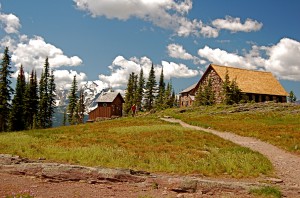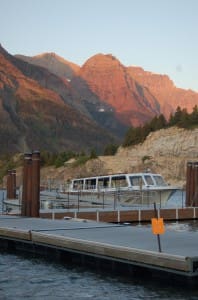Designated in 1910 as the nation’s 10th National Park, the grandeur of Glacier has attracted visitors for centuries. The Blackfeet Indian tribe that dominated the plains east of the mountains frequently wintered in the wooded valleys of what is now Glacier National Park, and considered the area around Two Medicine sacred. The Kootenai, who made their homes west of the Continental Divide, used the mountain passes to reach their buffalo hunting grounds near Waterton Lakes. Marias Pass on the south border of the park is one of the United States’ lowest Continental passes.
Lewis and Clark, on their 1805 westward journey, passed within 50 miles of Marias Pass before turning south. Although sought for years by white explorers, the pass remained unknown to whites for almost another century, and the land relatively untouched. In 1889 John Stevens, an engineer surveying a route for the Great Northern Railroad crossed Marias Pass, a crossing that would have historic implications for the area.
In 1893, the first Great Northern train crossed Marias Pass on the newly laid Great Northern Transcontinental Railway. In an effort to generate traffic, the Great Northern began to promote Glacier as a tourist destination. The G.N. advertised the region as “the Switzerland of North America” and began to develop a series of lodges and chalets in a distinctive combination of western and Swiss styles. These projects included the Lake McDonald, East Glacier and Many Glacier Lodges, as well as the historic Granite Park and Sperry Chalets. Glacier owes much of its preservation, promotion and style to the Great Northern Railroad, and the G.N. owed much to Glacier. In fact, the G.N. maintained its Glacier concessionaire company, despite the fact that the company consistently lost money, because tourist traffic was so important to the railroad.
One visitor to the area was George Bird Grinnell. Enchanted by the region, and convinced that it merited protection, Grinnell spent a decade petitioning for the creation of a National Park. Finally, in 1910, President Taft signed into law the creation of Glacier National Park. Today, Glacier is the core of the Crown of the Continent Ecosystem, one of the most pristine remaining Rocky Mountain environments. And, in a careful combination of conservation and tourism, the park is a popular tourist destination, receiving over 2 million visitors each year.





